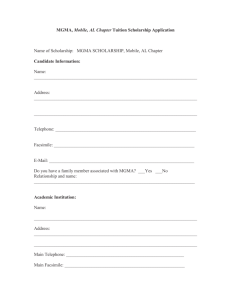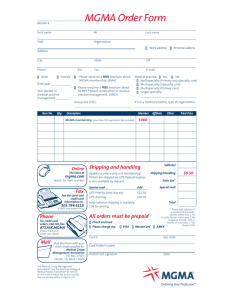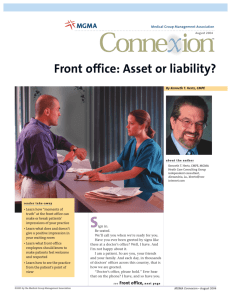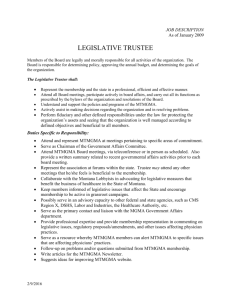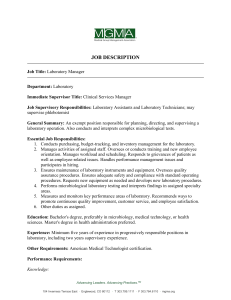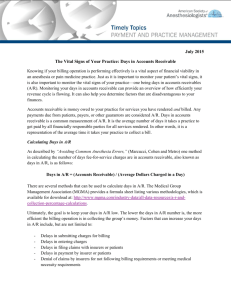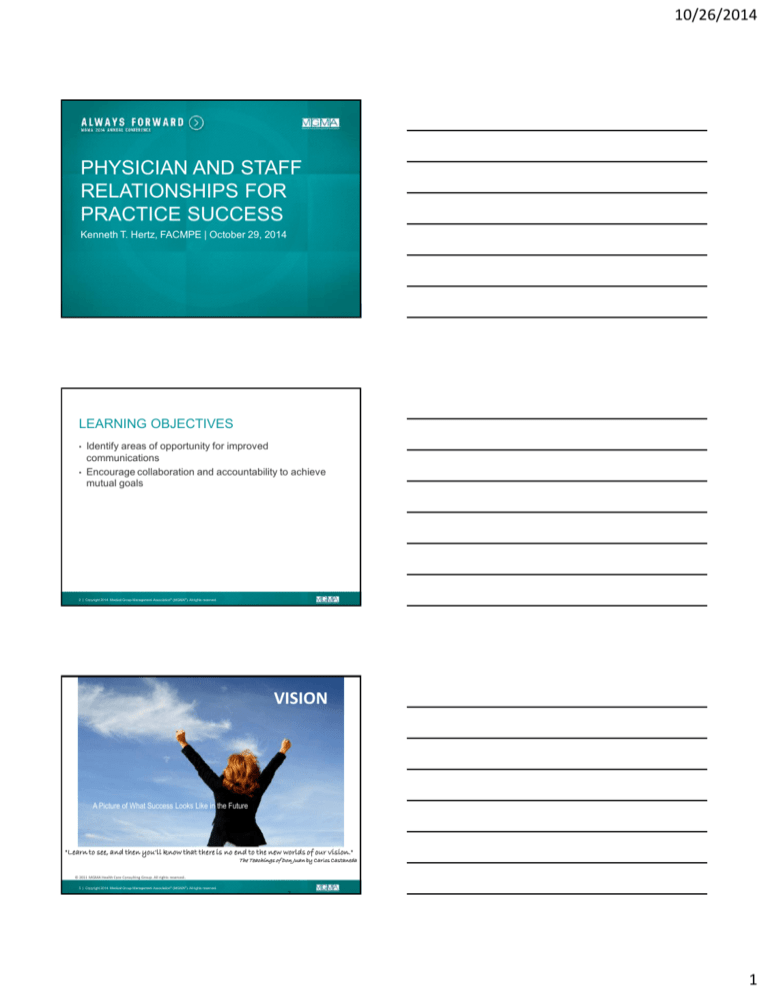
10/26/2014
PHYSICIAN AND STAFF
RELATIONSHIPS FOR
PRACTICE SUCCESS
Kenneth T. Hertz, FACMPE | October 29, 2014
1 | Copyright 2014. Medical Group Management Association® (MGMA®). All rights reserved.
LEARNING OBJECTIVES
•
•
Identify areas of opportunity for improved
communications
Encourage collaboration and accountability to achieve
mutual goals
2 | Copyright 2014. Medical Group Management Association® (MGMA®). All rights reserved.
VISION
A Picture of What Success Looks Like in the Future
"Learn to see, and then you'll know that there is no end to the new worlds of our vision."
The Teachings of Don Juan by Carlos Castaneda
© 2011 MGMA Health Care Consulting Group. All rights reserved .
3 | Copyright 2014. Medical Group Management Association® (MGMA®). All rights reserved.
3
1
10/26/2014
The single biggest
problem in
communication is the
illusion that it has
taken place.
-George Bernard Shaw
4 | Copyright 2014. Medical Group Management Association® (MGMA®). All rights reserved.
FOUR BASIC LAWS OF NATURE
Interpersonal
communication is
inescapable
Interpersonal
communication is
irreversible
Interpersonal
communication is
complicated
Interpersonal
communication is
contextual
5
5 | Copyright 2014. Medical Group Management Association® (MGMA®). All rights reserved.
Wiio’s Laws of Communications
If communication can fail, it will.
If a message can be understood in different
ways, it will be understood in just that way which
does the most harm.
There is always somebody who knows better
than what you meant in your message.
The more communication there is, the more
difficult it is for communication to succeed.
Source: Osmo Wiio, Wiio’s Laws-and Some Others,
Espoo, Finland: Welin-Goos, 1978.
6
6 | Copyright 2014. Medical Group Management Association® (MGMA®). All rights reserved.
2
10/26/2014
BARRIERS TO COMMUNICATION
Power/Authority/Intimidation/Status
Human nature
Cultural diversity
Facility and equipment
Chain of command/Red tape
Size of organization
Lack of opportunity
Sender breakdown
Receiver breakdown
Nobody listening
Stress/Under fire
Other
7
7 | Copyright 2014. Medical Group Management Association® (MGMA®). All rights reserved.
What about what’s not said?
Kinesics – body movement
Oculesics – eye contact/movement
Haptics – touching behavior
Proxemics – personal space usage
Chronemics - time
Paralanguage – non-word cues
Tone of voice
Pitch
Volume
Emphasis
Face
8
8 | Copyright 2014. Medical Group Management Association® (MGMA®). All rights reserved.
OPPORTUNITIES
•
•
•
•
•
•
•
•
•
Share the vision!
Front desk
Meet the Doc
Annual Meeting
Quarterly Meeting
Daily
Huddles
Celebrations
Social activities
9 | Copyright 2014. Medical Group Management Association® (MGMA®). All rights reserved.
3
10/26/2014
HIGH PERFORMING
ORGANIZATION
10 | Copyright 2014. Medical Group Management Association® (MGMA®). All rights reserved.
THREE BARRIERS TO BECOMING A HPO
1. Failure to Track
2. Bottlenecks
3. Too much CYA
Mankins, M.C., Steele, R., Turning Great Strategy into Great
Performance, Harvard Business Review, July-August 2005
11 | Copyright 2014. Medical Group Management Association® (MGMA®). All rights reserved.
The research shows…
•
Seven habits of highly effective groups
1.
2.
3.
4.
5.
6.
7.
Spend more to make more
Focus on productivity and teamwork
Monitor performance against benchmarks
Create an effective physician/administrator team
Establish good communication
Rightsize the staff
Focus on patient-centered care
Gans, D., The seven habits of highly effective Medical groups, Connexion, February 2008.
12 | Copyright 2014. Medical Group Management Association® (MGMA®). All rights reserved.
4
10/26/2014
THREE CHARACTERISTICS OF A HPO
1.
2.
3.
Bring out the best in people
– Produce organizational capacity that supports
sustainable results
Put people first
Emphasis on intellectual capital (IC)
– IC is the foundation of HPOs
– Organize work flow around key business processes
– Utilize work teams
Organizational Behavior, John Wiley and Sons.
13 | Copyright 2014. Medical Group Management Association® (MGMA®). All rights reserved.
FIVE KEY COMPONENTS OF A HPO
1.
Employee involvement
–
2.
–
–
–
3.
Flexibility in job design and IT
Use of computers
Organizational learning
–
5.
Empowered to make decisions about planning, doing and evaluating work
Need to tap employees expertise and knowledge
Need for employees to manage themselves
Integrated production technologies
–
–
4.
Amount of decision making delegated at all levels
Self-directed work teams
Gather information to anticipate future changes
Total Quality Management
–
–
–
Commitment to high quality results
Continuous improvement
Meeting customer needs
Organizational Behavior, John Wiley and Sons.
14 | Copyright 2014. Medical Group Management Association® (MGMA®). All rights reserved.
THE SECRET SAUCE
ADAPTIVE CAPACITY
An organization's ability to learn,
and translate that learning into
action rapidly, is the ultimate
competitive advantage.
- Jack Welch
15 | Copyright 2014. Medical Group Management Association® (MGMA®). All rights reserved.
5
10/26/2014
RTW
•
•
•
•
•
What can you do to improve
your verbal communication?
What “shared symbols” are
causing you the most trouble
and how can you change that?
What barriers in your office
prevent effective
communication?
What can you do to become a
more active listener?
What non-verbal
communication areas do you
need to focus on?
16
16 | Copyright 2014. Medical Group Management Association® (MGMA®). All rights reserved.
QUESTIONS?
17 | Copyright 2014. Medical Group Management Association® (MGMA®). All rights reserved.
6

